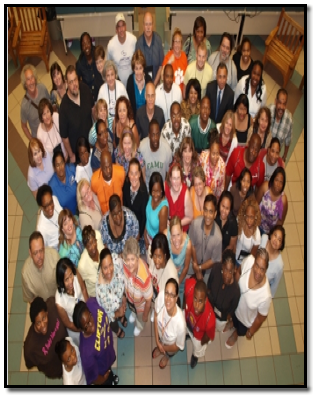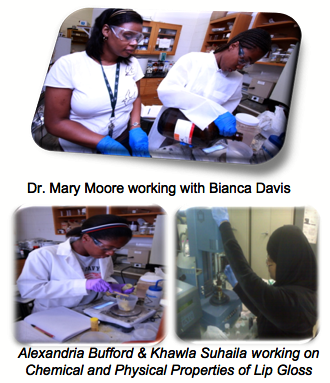JSU-PREM Participants presented Nanoscience exhibition at the Memphis Zoo, Memphis, TN. Over 300 Participants gathered at the Zoo for Nano Day
JSU-PREM Participants presented Nanoscience exhibition at the Memphis Zoo, Memphis, TN. Over 300 Participants gathered at the Zoo for Nano Day
We have developed SERS based sensor for extremely toxic cyanide ion recognition quickly, selectively and accurately without any tagging, at 110 ppt level.
 Self-assembled block copolymers (see the upper inset) can accommodate nanofillers in given polymeric domains resulting in an ordered spatial distribution of nanoparticles, induced by the self assembly of block copolymers and the preferential trapping on the nanofiller (see the left figure).
Self-assembled block copolymers (see the upper inset) can accommodate nanofillers in given polymeric domains resulting in an ordered spatial distribution of nanoparticles, induced by the self assembly of block copolymers and the preferential trapping on the nanofiller (see the left figure).
Ultra-thin films of block copolymers filled with various nanoparticles can be obtained from solution by spin-coating.
 Advanced energy absorption systems have recently been developed, in which external work is converted into stored energy by infiltrating nanoporous materials with liquid phases.
Advanced energy absorption systems have recently been developed, in which external work is converted into stored energy by infiltrating nanoporous materials with liquid phases.
Three-dimensionally ordered mesoporous (3DOm) carbon is studied as a new nanoporous material matrix for energy storage. 3DOm materials in general have the property of highly interconnected pores and large surface areas.
3DOm carbon is synthesized by replication of 10-40 nm silica nanoparticle arrays. Phenol-formaldehyde (PF) and resorcinol-formaldehyde (RF) were used as the carbon sources to replicate silica spheres.
 We work on an fabrication method for “artificial” photonic quasi-crystal. The fabricated Penrose-type photonic quasicrystal shows ten-fold rotational symmetry. The Laue diffraction pattern from the photonic quasi-crystal is observed to be similar to that of the traditional alloy quasi-crystal. A golden ratio of 1.618 is also observed for the radii of diffraction rings, which has not been observed before in artificial photonic quasicrystals. (see Fig. 1)
We work on an fabrication method for “artificial” photonic quasi-crystal. The fabricated Penrose-type photonic quasicrystal shows ten-fold rotational symmetry. The Laue diffraction pattern from the photonic quasi-crystal is observed to be similar to that of the traditional alloy quasi-crystal. A golden ratio of 1.618 is also observed for the radii of diffraction rings, which has not been observed before in artificial photonic quasicrystals. (see Fig. 1)

The major drawback of solar cell technology is the low efficiency. Introducing PhCBR would allow for higher efficiencies that improve over current metal back reflectors. The better the reflective properties for the designed back reflectors allow for light to be trapped within the solar cell longer, thus allowing for a higher percentage of photons to be absorbed to produce electrical power.
 On April 9th, 2011, a state-wide assortment of 22 middle school teachers and administrators participated in three distinct presentations as part of the Spring NanoBio Science Academy for teachers (NBSAT). NBSAT focused on the professional development of teachers with an emphasis of nano and biotechnology. In addition, the academy provided strategies proven effective with at-risk and diverse learners to increase minority participation in STEM.
On April 9th, 2011, a state-wide assortment of 22 middle school teachers and administrators participated in three distinct presentations as part of the Spring NanoBio Science Academy for teachers (NBSAT). NBSAT focused on the professional development of teachers with an emphasis of nano and biotechnology. In addition, the academy provided strategies proven effective with at-risk and diverse learners to increase minority participation in STEM.
 Tuskegee University Center for Advanced Materials (T-CAM) hosted high school students during the summer of 2010 in an effort to expose the students to research and concepts pertaining to science, engineering, and technology. Research Experience for High School Students (REH) program occurred over an eight-week time frame during June-July 2010. Students will participated in a series of ACT preparation classes as well as perform mini-experiments demonstrating concepts and ideas relevant to science, engineering, and technology. The REH students were mentored by recent PhD graduates and current graduate students in Materials Science and Engineering.
Tuskegee University Center for Advanced Materials (T-CAM) hosted high school students during the summer of 2010 in an effort to expose the students to research and concepts pertaining to science, engineering, and technology. Research Experience for High School Students (REH) program occurred over an eight-week time frame during June-July 2010. Students will participated in a series of ACT preparation classes as well as perform mini-experiments demonstrating concepts and ideas relevant to science, engineering, and technology. The REH students were mentored by recent PhD graduates and current graduate students in Materials Science and Engineering.
Objective of this study is to study the influence of functionalization of MWCNTs on the performance of nanocomposites.
Approach: In this work, thermoset polymers were modified with pristine and amine functionalized MWCNTs. Thermomechanical thermal, rheological, and mechanical characterization was carried out.
Objective of this work was to test the thermal and mechanical properties of POSS coated SiC particles infused in epoxy polymers to produce nanocomposite. A non-contact and sonochemical method was developed to coat POSS on SiC nanoparticles and uniformly disperse in a polymer. These epoxy based polymers were further cured to prepared polymer nanocomposites.
Nanocomposites with 1% loading of both SiC and POSS coated SiC are shown in figure. The flexural strength was increased by 12% and 14.3% over the neat epoxy. The flexural modulus were also increased by 9.5% and 12.5% respectively with no loss in strain to failure. It should be noted here that with reducing the amount of SiC by 50% in coated nanoparticles, still it is possible to increase the mechanical and thermal properties.
On April 29, 2011 Wi(PR)2EM and the Science on Wheels Educational Center (SONW) organized and coordinated the First Arts, Sciences and Engineering Festival of UPRM (FACI-RUM, was its acronym in Spanish) at the Rafael A. Mangual coliseum at UPRM. This large event combined our NanoDays activities with the 20th anniversary of SONW as well as the Weather Fest 2011.
Beta-peptides have been designed to mimic natural host-defense peptides. Unfortunately, very little is known about the molecular mechanism of action of these materials. During the past year Dr. Ortiz-Bermúdez and her research group have been conducting experiments in collaboration with Dr. Sean Palecek, from the Department of Chemical and Biological Engineering at the UW-Madison, to elucidate the mechanisms of action of antifungal beta-peptides. This project focuses on a genetic approach involving the use of a Saccharomyces cerevisiae strain SPY760 exposed to a random gene mutagenesis with mini-Tn3::LEU2 transposon and a non-mutagenized S. cerevisiae strain SKY760 to identify the molecular response of a yeast cell upon exposure to beta-peptides. Screening of beta-peptide resistant mutants revealed several genes; of special interest is the Hsp 33p gene. This gene belongs to a family of heat shock proteins expressed particularly during oxidative stress.
Carbon-rich compounds and materials have garnered much attention recently due to their small band gaps and thus applications as organic conductors and ferromagnets that form monolayers in solid-phase state. One such type of materials that can form carbon monolayers are [N]phenylenes, hydrocarbons built of fused alternating aromatic benzene and anti-aromatic cyclobutadiene rings. Vollhardt’s group has developed efficient synthetic routes to this family of compounds, including helical angular phenylenes.
As a precursor for circular phenylenes, PhenyleneCl4 crystals were studied. Scheme shows transformation of molecular material into monolayers with potential conducting properties.
Planar electron-accepting π-systems are useful building blocks for both nonlinear optical and organic electronic applications.
We have recently developed a convenient synthesis of dibromo bithiophenes and bithiazoles of type I (see below) that relies
upon the base-catalyzed “Halogen dance”, in which the lithiation initially takes place adjacent to the bromine atom, before
changing places with it. Compounds I can be converted to a variety of tricyclic species including the keto and diketo species
shown on the right. The structures of representative examples of intermediates and products have been confirmed by X-ray
crystallography.
A series of presentations on light-matter interactions have been given at the West Las Vegas Middle School. These have served to promote
connections between local schools and PREM program.
Three NMHU PREM students organized four different science presentations, each approximately one hour in length for 80 students total
for the science class of Mr. Michael Tenorio (7th grade).
Topics covered: